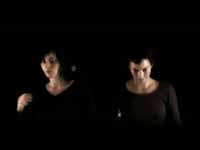

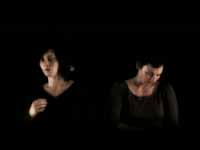



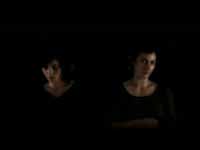
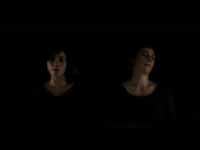

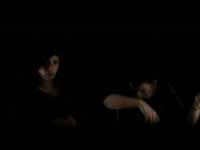
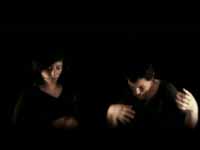


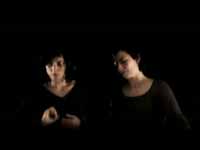
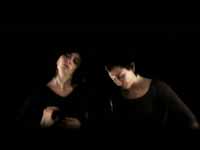

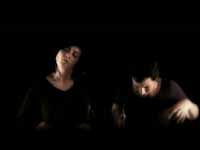



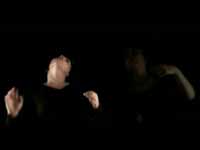






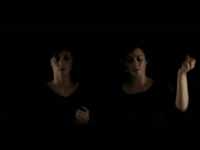

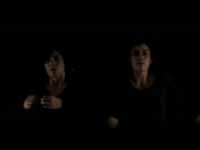


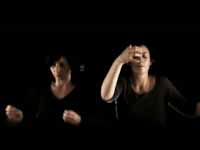
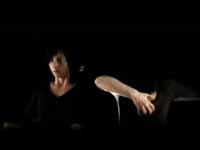

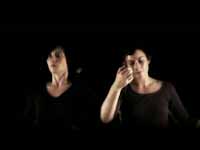







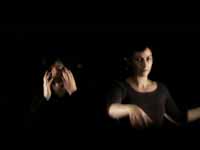


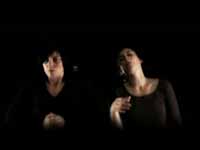




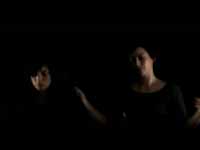

Presented at Bodies of Thought, 3 April 2009, Siobhan Davies Studio, London

 I should advise you that I'm here under false pretences, first because I am not a dance specialist. Secondly, although I was invited here as an academic, to speak 'about Rosemary Butcher's work', I have agreed to appear only if I can be joined by the artist herself. There are many reasons for this requirement: first of all, thanks to funding by the Arts and Humanities Research Council, some of us in the university 'economy' have been able to bring professional artists into the university as researchers – and this is Rosemary's case. One consequence of this research funding is that there has been a shift in the notion of the academic as far as the arts are concerned. Some of us are no longer quite so comfortable to write 'about' contemporary arts – an objectifying formula – for the simple reason that the artist-researcher can speak for herself and for her ways of working. In this case today, 'the artist' is a senior colleague of mine at Middlesex University.
I should advise you that I'm here under false pretences, first because I am not a dance specialist. Secondly, although I was invited here as an academic, to speak 'about Rosemary Butcher's work', I have agreed to appear only if I can be joined by the artist herself. There are many reasons for this requirement: first of all, thanks to funding by the Arts and Humanities Research Council, some of us in the university 'economy' have been able to bring professional artists into the university as researchers – and this is Rosemary's case. One consequence of this research funding is that there has been a shift in the notion of the academic as far as the arts are concerned. Some of us are no longer quite so comfortable to write 'about' contemporary arts – an objectifying formula – for the simple reason that the artist-researcher can speak for herself and for her ways of working. In this case today, 'the artist' is a senior colleague of mine at Middlesex University.
What this means is that it would be ethically inappropriate for me, as her colleague, to suppose that I can speak, unproblematically, 'about Rosemary Butcher'. As soon as I utter the words 'about Rosemary Butcher', a theoretical dimension as well as the ethical problematic, is revealed. The theoretical difficulty lies in the question of what might be understood by the expression 'about Rosemary Butcher'. It tends not, actually, to name a person 'in the world'. Conventionally, in invoking the name of a choreographer, it is likely that I and those I speak with are using her name to invoke her past works, through which many of us here probably know the artist. Yet the artist may prefer to think of herself, as artist, in the future tense. Nonetheless, we tend to utter the proper name as a shorthand for the work itself – or rather, as I want to stress tonight, for our experience of it, which is not the same thing at all; but from that point of view, what we are calling 'the work' tends, conventionally, to be seen as more significant than either the person or, in Performance Studies terms, the professional.
Hence once the person and the professional assume the role of a colleague in the university, I am obliged to ask 'what's in a name?'. The immediate answer is: possibly a whole raft of quite different things, some of which are prioritised in the university, others of which are prioritised elsewhere. Given this possible complexity, my position here is far from straightforward: I am more than happy to speak 'with' the professional, Rosemary Butcher; on the other hand, I'm reluctant to try to talk 'about her work', in conventional, objectifying, or 'academic' terms. I am hoping that she will herself speak about her making processes, tonight, in this particular place, rather than 'about her work', and about what it is that I am seeking to identify under the heading of an enquiry into 'signature'. I am using 'signature' here for a number of reasons, one of which is because it tends to have been erased from or overlooked in Performance Studies or Dance Studies writing over the past few decades despite recurring 'academic' interest in (the work of) notorious, named practitioners. (I have described this curious state of academic affairs, elsewhere, as constitutively ambiguous). Where the word does appear, it does so implicitly, and it is rarely theorised, yet surely one of the most intriguing questions, of art-making, is "how does she or he work?" rather than, what has she already made?. Nonetheless, I am suggesting that the notion is a significant one: we paradoxically reference something like 'signature', implicitly, whenever we invoke the name of Pina Bausch or Wayne McGregor, or Siobhan Davies, yet some of us tend to do so without unpacking precisely what we understand the name to mean.
In my argument, then, when academics do use the proper name, we are actually referring not simply to notable practices, but to the 'quality' of those signature practices through which the name has achieved its professional as well as aesthetic significance for us. Signature, in terms of major discourses, always signals a complex judgement made, for and on behalf of others, but it generally does so without the acknowledgement, by those who exercise that judgement, that we need to identify explicitly on what bases we have grounded it. I would argue that one of those bases lies in the responses of the wider arts communities, and in the written reviews that tend to signal something of that wider response: on this basis, what I am calling 'signature', or signature practices, is relational – it signals a relationship with a range of others at the heart of judgement – rather than something that is immanent to 'the work itself'.
But what are 'signature practices' when we are concerned with dance and the named choreographer, and on what range of factors, shared amongst how many people, does our often implicit judgement of taste and value depend? I want to go so far, tonight, as to suggest that academic researchers of a certain generation have conventionally lacked the means to elaborate 'artistic signature' for historically-specific reasons: 'signature' was identified, in later 20thC theoretical writing, as a prison, as a set of constraints to be broken out of; as a curious combination of the reiterable and the singular, or the paradoxical relationship between originality and repetition. It seems to me to be appropriate, at this stage, to show you part of a recent commission that I am arguing bears RB's signature: entitled Six Frames: Memories of Two Women: the piece was made in Dublin (2005) at the project Upstairs art space, with and for Liz and Jenny Roche, and RB has described the making processes, which she has developed elsewhere with the dancer Elena Giannotti, as inviting the dancers to 'Look […] and identify […] within memory, then physicalising the memory, and then going back to the idea again' (see Butcher and Melrose,Choreography: Collisions and Collaborations, MUP 2005). In discussion with Rosemary, she described what she was looking for, in the Roche sisters: to look at two women ‘experiencing something’, over time, without our knowing, as spectators, what that ‘something’ might be.
Now for what I understand 'signature' to mean: although in commonsensical terms, a 'signature work' is one that readily identifies its creator, in certain instances of Freudian-informed, later 20thC theorising – for example by Jacques Derrida in the early 1970s – signature has been described as quite the opposite of a sign that its creator had once been present. Instead, signature is identified as a veil which conceals nothing – because it has nothing behind it. That nothingness, in turn, it was argued, could be characterised as feminine, in that its nothingness signals an act of castration that has (‘always’) already happened. This might recall, for some of you, Roland Barthes' notion from 1967 of the death of the author, which argued against incorporating the intentions and biographical context of an author into an interpretation of text, because writer and creator are, in fact, unrelated. In my own view, the authority of the signature addended to a letter or contract holds good, in the absence of the writer, only where there is an a priori agreement, of a formal and legal kind, that it should. Once again, its authority lies external to the signature itself, and it is equally relational, requiring at least two parties in negotiation. Well and good. However, I would argue that the transfer of the writing-theoretical 'apparatus' identified above, to arts practices lying outside of text, that are constitutively unlike text, is curious: what might this conception of authorial signature have to do with expert art practitioners and their work, and ourselves, when that work and our own engagement with it lies, significantly, outside of writing?
I would argue that an example of signature practices that might be more useful to us here as an 'external measure' for choreographic practices, is the visual arts practices of painting, which, even literally 'unsigned', can oftentimes be analysed to reveal the marks of signature in its most minute detail. In this instance of the visual arts, it would seem, signature can be recognised in, for example, brushstrokes: in such a case, 'signature practices', actualised in the painting, are dispersed across the work, rather than identifiable 'here of there', as it were. And they refer us back not so much to the painterly theme or subject, but rather to the painting as recording a way of working that is specific to a particular artist. In Deleuze's work on Francis Bacon, while the latter was still alive (this is a rare enough aspect, as far as French philosophical writing is concerned) the former identifies the preparatory traces of signature in the first lines, diagrammatically identifiable, that Bacon marks on a canvas. (If you are not aware of Deleuze's text, it is worth looking for it, but be aware that the English-language publication fails to include the companion publication of photographic representations of the painter's work, in which terms the written text in English is diminished in terms of its signification.) On this rather flimsy basis, I am prepared to suggest that 'signature' is likely to be dispersed 'in a work', rather than monolithic; it is likely to be available as a record of processes of making, rather than either prior to or necessarily after the work has been made public); it need have nothing to do with a name impressed onto the canvas; but when its marks are gathered together, by an expert onlooker, it identifies and is identified as an expert and named way of working ('work', here, is a verb, to do with making something, rather than a noun as in ‘the finished work’).
I suspect that there are further historically-specific reasons for Performance Studies' and Dance Studies' often failing to theorise signature as central to our ways of seeing and understanding work that works (us), and how and why that occurs. These ways of seeing and understanding are called 'models of intelligibility', and I add this because it is sometimes useful to be able to formally reference something that seems relatively abstract, individualised, and a-theoretical. It may be generational: many of my university colleagues and I, of a similar generation, were encouraged, from the 1970s onwards, to reject (the indices of) expertise or mastery, or signature practices, in a particular discipline, such as Performance Studies. For ideological reasons, we were encouraged, often implicitly in the name of an avant-garde that particularly interested 'radical' theorists of the period, to pursue the anti-disciplinary, in performance or other art practices, in place of disciplinary mastery and expertise. This was in part because the university itself could not afford to teach performance expertise of a singular, signature-specific kind. At the same time, it aspired to what might now be seen as a fanciful attempt at the democratisation of (access to) art. According to that pseudo-democratised anti-disciplinary aspiration, disciplines such as dance and acting-based performance were widely rejected by theoretical writing itself, where that theoretical writing took as its primary goal a critical-theoretical dismantling and transformation of institutionalised knowledges, ill at odds, it might seem, with the processes of making new work outside the institution. These were replaced in the 1980s, as the object of theorising, by the arts of the pedestrian, a poetic of the everyday, that is, to all intents and purposes, both banal and 'unsigned', anonymous. Pedestrian arts have little to do with the sort of creative decision-making that I am talking about here, and little to do with the signature of the established practitioner. I have argued elsewhere, by the way, that there is nothing 'everyday' at all about RB's consistent recourse to a highly trained dancer who then performs, and thus invites us to thematise the everyday: here the performing (expert, singular) is constitutively unlike the performed (everyday anonymous), and it is in this that part of its impact can be found.)

Interdisciplinary performance was similarly pursued, in the university, in the late 1980s and 1990s, as an interrogation of and challenge to discipline, and the emphasis in the university was placed instead on the delivery of knowledge, and on knowledge systems, rather than on a disciplinary mastery that was judged to be excluding rather than inclusive. On interdisciplinarities, I have argued that an interdisciplinarity practised by expert practitioners in different disciplines is radically unlike the interdisciplinarity pursued in many undergraduate performance programmes, which is celebrated in terms of its supposed attention to liminalities, boundary-pushing, or hybridity. Nonetheless, under the influence of the Social Sciences, some of us in the university system in the 1980s and after have written more comfortably, from our position as spectator-academic, about cultural systems (likely to be anonymous), than about the singular ways of seeing, doing and knowing, about the mastery and the peculiarity of the work of one or another notorious practitioner whose name is held as a stand-in for that work.
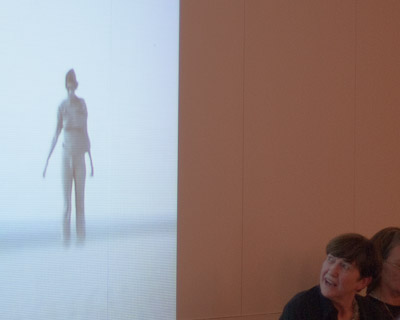
Not wanting to speak, then, 'about Rosemary Butcher', as though she were not present – it is, besides our engagement with 'the work' that we use her name to stand for – does not however prevent my having something to say tonight about my experience of her work in one or another performance venue, at one or another time. For me to stress the words 'my experience of her work in one or another performance venue, at one or another time', should give you a clue as to where I speak or write from: I am an expert spectator. Anything I might want to say or write 'about RB's work', comes from that position of spectating, and, according to various philosophers, what I have to say or write, as expert spectator, is almost certain to be calculated on and written from the position of spectating, informed by the modes of knowledge and the models of intelligibility that are specific to spectating. (Looking, for example, is rendered primary, for obvious reasons, in spectating, yet looking is not prioritised by many expert performers who, besides, will never see themselves from where we see them; and were they to look, at any rate, at the same work, their own affective investment in it means that they are unlikely to see what spectators see.)
Now, spectating is a curious, voracious practice or set of practices, which have both a particular positioning and a peculiar quality to them: I have often written elsewhere that almost by definition, a spectator can only see what a spectator can see, by which I mean that my access as spectator to 'Rosemary Butcher at work' is both strictly limited, in time and in space, and it is calculated on the basis of seeing from that safe distance, from the work, that is specific to spectating. I have suggested that many of us are taught to believe that we see more than we actually do see, and to invent the rest, according to one or another mode of interpretation provided in university programmes. I do want however to contradict that observation of mine tonight in order to say that when I 'see dance', my mind's eye irresistibly brings me other dance performances experienced, and registered, somewhere, in my memory. When I see Rosemary Butcher's Memories of Two Women, for example, I find that I am looking for Rosemary in the work. And my mind's eye brings, to that event, my retained experience of her Vanishing Point and her Hidden Voices, such that I am made aware that my retained experience of these constitutes a palimpsest which will undoubtedly inform my ongoing evaluation of the new experience.

I am likely to seem to see moving patterns, schemata, or patterns of movement, something equivalent perhaps to Francis Bacon's curious initial brushstrokes that will be taken up, diagrammatically and rhythmically, in his finished works. I experience a rhythmic recognition, that calls back to me the rhythm of those other works by RB. I bring these layerings of 'stuff' retained, as well as earlier judgements with which these are now threaded, and what this means, once again, is that I am constitutively unlikely to see 'Rosemary Butcher's work' in entirely its own terms. Curiously enough, given these observations, I am nonetheless likely, on this basis, to construct a more or less mythical 'Rosemary Butcher' in my own terms. This complex restaging from the position of my spectating prompts a particular question: if spectating involves modes of knowledge and models of intelligibility that are specific to the spectator's position and the spectator's ways of knowing, what might an expert practitioner's modes of knowledge and models of intelligibility be like? (One practitioner-specific knowledge-mode, in my experience, is the quest for ‘integrity’, yet in practitioner terms, this has a performer-technical significance – it concerns a particular type of expert energy focus and attention to detail – rather more than the metaphysical significance that Performance Studies discourses once deplored.)
How, given this complex engagement and the constitutive ambiguities involved, might some of us escape the prison of spectating, in order to attempt to engage with 'the work of making itself'? What I need to say about my expertise in spectating is that it has tended to prevent me from theorising performance‑making, as distinct from that spectator engagement in the times and spaces of the performance event. In the absence of a proper basis from which to theorise performance‑making processes, I might, as expert spectator, be encouraged to put forward one or another informed hypothesis as to what might have gone on in the performance-making processes; but because I have invited the artist herself to be present tonight, those informed hypotheses are revealed to be just that: I was not there, in the making. I cannot offer you effects, and argue that on their basis I can understand performance-making causes. What do I know about performance-making from its outcome – or rather, what can I know of it? On the other hand, if I were content to construct inferences about the processes of making, on the basis of my experience of their outcome, then I would be like so many of my academic colleagues in the 1980s and 1990s: I should be a myth-maker, masquerading as a performance analyst, and pretending that I know more about what went on in the making, than the artist herself knows.

I prefer not to do that (any longer). In preferring not to do that, I am inviting you, in this place, to acknowledge what many of you know: that there are knowledges specific to performance-making expertise, that are almost certainly only available to those who participate in them. It is likely however – as far as I have been able to tell – that the expert practitioner involved avoids verbalising many of these knowledge areas, simply because that verbalisation is not useful to the making; verbalisation tends, besides, not to ask the questions the maker asks, of herself as well as her collaborators. Her knowing, in addition, is likely to be felt, or sensed, while also being wholly reasoned in expert choreographic terms.
These are not the ways of knowing that some of us argue are more prevalent and valued in the university, where some of us pretend that our professional activity is free of intuitive process and feelings; yet where choreographic knowledges are expertly sensed and expertly felt, they are likely by the same token to be disciplined, rigorous, and systematic in their eventual involvement in the making. In addition, many of the knowledge types specific to expertise are likely to involve expert-intuitive processing: what I mean by this is that there is an intuitive method specific to art-making in expert hands, just as there is – according to Henri Bergson – an intuitive method specific to philosophising in expert hands. In dance-making, this expert-intuitive processing is complex, multi-faceted, multi-dimensional, differentiated in time, and it consistently participates in decision-making taken in choreographic composition, as well as in a dancer's own invention: it is, therefore a key aspect of professional expertise.
It is worth observing, in addition, that there may well be knowledge about Butcher's expert performance-making that is differently known by her collaborators, in contrast with what RB herself knows. After all, each of her collaborators is similarly expert, in different areas of expert practice, and Rosemary draws on their particular expertise precisely because it lies outside her own. The anti-disciplinary tendencies of the last decades of the 20thC are not central to RB's work. On the contrary, Rosemary's work emerges from her collaboration with trained, expert dancers, visual artists, composers and film-makers, each of whose name is professionally established, and the outcome of that collaboration is both entirely professional, signature-marked, and singular to her or him. As for me, as I have said elsewhere, I can't dance (don't ask me!) and my mastery, if it exists, lies elsewhere – although I have been trained in such a way that it seems that I have the right to comment expertly on performance-making's momentary instantiation in the performance-event.
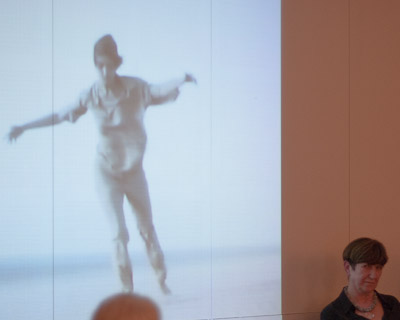
It is against this sort of background that I am arguing tonight that were she not present, we might look at the notion of artistic singularity, taking 'Rosemary Butcher's work' – in the forms that we know (of) it – as something like a case study. We would probably look for indices of (historically-specific) originality, plus perceived coincidences running across the body of work – and that sort of process is likely to reveal exactly what we are looking for, that we can then present, almost triumphantly, as confirmatory evidence! Because RB is present, however, I suggest that we focus on another of her more recent works, Vanishing Point (2003), which I am arguing bears her recognisable 'brushstrokes', while also revealing her ongoing and changing ways of working professionally. VP results from RB's expert collaboration with the dancer, Elena Giannotti, the film-maker Martin Otter, with music by composer, Walter Fahndrich. Once again, Vanishing Point seems to reveal the paradoxical relationship between that originality and reiteration that might be associated with (historically-specific) singularity and/as signature, but I want to add the notion here that it is on the basis of our engagement with different works – not, thus, 'the work itself', but across a number of works – that we start, as expert spectators, to grasp the notion of the artist’s sensibility – whether we do so implicitly, as academics, or explicitly. The notion of the artist's sensibility, the notion of sensibility in the expert practitioner, once again, is left out of Performance Studies theorising, in large part because what I am calling the artist's sensibility is difficult to identify within the knowledge systems preferred by social sciences-influenced theoretical writing.
The sensibility of the artist is developed over time, and as such it is time and context-sensitive; sensibility is constantly evolving, but it is likely to be grounded in something like Bourdieu's notion of habitus (if we were able to borrow the notion of habitus while depriving it of its ideological engagement): that is, in a cluster of tendencies, attitude, ethos, a taste for risk and experimentation and a sense of the possible that is durably installed in the artist from her or his early years, and enabled and responded to, as such, over that period. The combination of singularity, signature effects and sensibility is calculated, as far as I can see, on a disciplinary mastery that confounds the anti-disciplinarity that I referenced earlier tonight; it is calculated, as well – and crucially – on the highly developed capacity to exercise judgement, at every stage of the performance decision-making, and over time, informed both by feedback, by life changes and by an attention to the changing world. This capacity for exercising judgement in the ongoing work processes, and explicitly at certain stages of these, is both vital to and is largely un-theorised in university approaches to performance and/or performance-making. The capacity for that exercise does meet, at certain points, a similar capacity in expert spectators, but it may equally change these.

What is central to RB's ways of working in choreographic practice, in which sensibility, singularity and artistic signature are clearly combined with the time-sensitive exercise of judgement, are the operations of that expert-intuitive method, that has, once again, been widely ignored in academic writing on dance, over the past few decades. The constitutive role of expert-intuitive method, in performance-making, has rarely been taken up in academic writing for one precise reason: the expert spectator cannot see it at work, although she cannot avoid its outcomes; but she is likely to misrecognise these as such. The expert-intuitive others the spectator – makes that spectator other – and that spectator, as long as she is expert, and academic, tends to dislike that othering, which makes her expert performance-making’s exile.
It is, in other words, as an exile that I have asked Rosemary Butcher to be here with us tonight. I am supposing that the presence of the signature practitioner imposes an ethical constraint upon me but it equally provides us with the opportunity to ask questions about the expert making processes and especially the decision-making processes as the work progresses, that academic expert spectators are otherwise not able to ask. With the increased academic interest over the past decade, at least, in how specific things of interest are made by expert practitioners, we have, without access to the artist as maker, to attempt to infer from our engagement with the work, the sorts of decisions the artist has made, attempting then to decode from the evidence what informed those decisions. Plainly this is a widely taught option even in the university but to my eye it is a foolish and dangerous one. As soon as I read in an undergraduate essay that 'what Butcher is trying to do in X piece or in Y' – and this is not unusual at all – then I think that we have reason for concern, and need a different approach.

The presence of the artist as maker is key, equally, to liberating some of us from the bind of discussing 'the work', where the word 'work' as I have already signalled, is a noun, and objectifying, suggesting an outcome that is fixed and given, as distinct from what keenly interests me, which is the ways Rosemary Butcher works with others, where 'works', as I reminded myself earlier, is a verb, suggesting not just a working process, but an internally differentiated and collaborative process over a time that is often determined by a given commission and a deadline. A way of working is a then a matter not just of process – which is a term widely over-used in recent practitioner approaches to Dance or Performance-making research – but of ongoing decision-making processes that produce the detail of performance, and affects its development, at every (different) point of the making, not least where that deadline is involved. We can see that process is internally differentiated, as soon as we recognise, as do many expert makers, that there is something particular about 'the work that finishes the work' (J-F. Lyotard, 1981: he uses the term in the sense Freud gives it in the psychoanalytic process, of working through) – or that finishes it enough so that it can be 'put out there', that it can 'go public'.
The work that finishes the work differs, as far as I can see, from other moments of investment, exploration, and enquiry: it is sometimes desperate, and always a compromise; it is the work that finishes the work that most keenly exposes the impact of the logics of production, in negotiation with the maker’s wishes, on the earlier decision-making. The deliberate bringing into play of the logics of performance production provides the makers with a basis for certain elements of the making process to be transformed, or omitted, or better orientated to an intended audience: it keenly and explicitly operates according – usually – to a named practitioner's professional judgement. In addition, the ways of working in Butcher's case are further differentiated internally by the fact of artistic collaboration, by which I mean, in part, that this collaboration brings the signature work of other expert practitioners into play – and negotiation – alongside and with choreographic process.

How can this systematic internal differentiation of the making processes be observed and accounted for, if as spectators our main experience is of the outcome of such processes? In my own experience, it is 'the artist' or 'artists' alone who can give academics access to decision-making detail, if we ask the right questions – and here is the rub: if academic writers are not to use the performance outcome as an effect, as though it would then allow us to invent performance-making causes, we need access, in the university, to complex, slow and detailed, often curiously intimate and fragile expert processes. That access is hard to obtain, and our presence in the making is often almost impossible for the makers to bear. As expert spectators, wanting something, and omni-attentive, we are greedy as well as purposeful. "Tell us how you did this or that!", cries the spectator-teacher, who wants the artist to strip off her own skin, or let us into her brain, in order that we might discover … what, exactly?
Now, many of you here will feel that you know something about 'Rosemary Butcher's work', and it is relatively easy, I have found, for students who have experienced one or two performances as spectator to feel that they can talk about 'Rosemary Butcher'. Certainly some dance critics write 'about Rosemary Butcher' as though the name of the artist and the work itself were – as some of us say in the university – 'co-terminus', or identical with each other. I would observe tonight, in this regard, that in this instance the work linked to the proper name stretches back over some three decades; it is currently, in 20091 'in production', hence changing; and new work will be made in the future: this ongoing, long-term production of work, each instance of which is 'new', and each of which, paradoxically perhaps, bears her name and is characterised by her signature, suggests that what is meant by the name, 'Rosemary Butcher', is dynamic, rather than fixed, and it is, paradoxically, both in flux, as well as partly stabilised, reiterative. The name of the artist, in this case, does seem to be related to an ongoing process of renewed expert experimentation, which means in turn that whatever is understood by the term 'the work' is incomplete, needs constant revision; by the same token the earlier pieces need to be historicised, marked with the date of their emergence, since the history of that emergence corresponds with Rosemary Butcher's professional life as an artist.

What is the difference then between the name of the artist, and the artist's signature practices? I am arguing that Rosemary Butcher, as artist, singularises a practice informed by a particular sensibility, within the discipline or disciplines concerned. It does not simply singularise it, but it does so expertly, and it does so in such a way as to stake a legal claim over the ways of seeing, doing and knowing that characterise the work. As audiences, we ratify that legal claim – we recognise it as valid, even at precisely that moment when some of our colleagues describe the work as 'austere' or 'minimalist' or 'difficult'. I have suggested that Rosemary Butcher's signature practices and what I have called her sensibility as an artist become recognisable in their outcome, over time, on the basis of our experience of more than one work; once emerged, these are stored in something like a collective mind-stock or memory, shared within significant parts of the arts community – not least where it is the case that the artist has taken an apparently radical step into film, taking her choreographic processes and her expert performers and designers with her, even though some spectators have to struggle to see the outcome as 'dance'.
To summarise, signature has legal status, is a mark of an agreed ownership and authority, and it is not wholly identical with the work that carries it, even though its 'impress', wrought in the making, can be deciphered across or 'through' that work. It tends always to be slightly less than identical with itself, by which I mean that the traits or qualities impressed are likely to undergo elaboration and modification, within an established limit, over time. My main point here, then, is that 'signature' is attributed to the outcome of certain creative processes: they make the outcome recognisably 'Rosemary Butcher's work', despite the fact that their own moment of emergence was in the making of it. It is certain that these traits or qualities that recur in the making processes themselves, that are more or less decipherable, from one piece to another, have a legal status, in terms of aesthetic property. Finally, they are constitutively unable to be reproduced by another artist, for the far from simple reason that these 'qualities' or traits are both singular to Butcher's ways of working, and they derive from a way of working collaboratively, that is hers. They derive from a way of seeing and doing and a sensibility and a capacity for the exercise of judgement that is her own, that is restless, and that is liable to grow and shift in response to contingent factors. Luckily, it is at work here tonight.
S. Melrose with Rosemary Butcher © 2009
1. Rosemary Butcher died in 2016, while working on a new production.
The images on the right-hand side are from Six Frames: Memories of Two Women, made in Dublin (2005) by Rosemary Butcher at the Project Upstairs art space, with and for Liz and Jenny Roche.
Other photography and web design copyright © John Robinson.
Text last updated 12th April 2019.